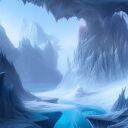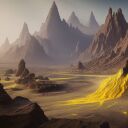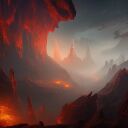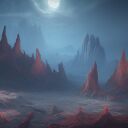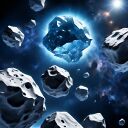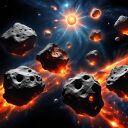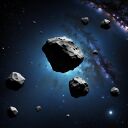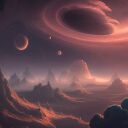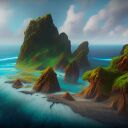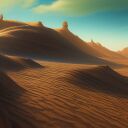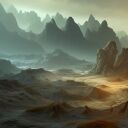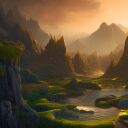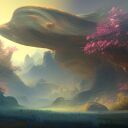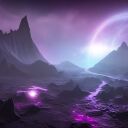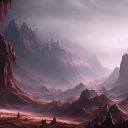More actions
Add broken world table |
Add description for barren world type |
||
| (8 intermediate revisions by the same user not shown) | |||
| Line 1: | Line 1: | ||
Planets are astronomical bodies that exist within star systems, outside of stars. | Planets are astronomical bodies that exist within star systems, outside of stars. | ||
== Barren == | |||
Barrens are uninhabitable celestial bodies, comparable in size to the Earth. Some are able to be [[Planet#Terraformation|terraformed]] into [[Planet#World|worlds]] under certain conditions. | |||
{| class="wikitable" | {| class="wikitable" | ||
! | ! | ||
| Line 9: | Line 11: | ||
|[[File:Planet ice.jpg|center|thumb|128x128px]] | |[[File:Planet ice.jpg|center|thumb|128x128px]] | ||
|Ice | |Ice | ||
| | |{{icon|gold}} 0-1{{icon|minerals}} 0-1 | ||
|Barren, icy worlds that are too cold to support life. They may have ice caps and frozen oceans, and their atmosphere may be thin or non-existent. | |Barren, icy worlds that are too cold to support life. They may have ice caps and frozen oceans, and their atmosphere may be thin or non-existent. | ||
|- | |- | ||
|[[File:Planet toxic.jpg|center|thumb|128x128px]] | |[[File:Planet toxic.jpg|center|thumb|128x128px]] | ||
|Toxic | |Toxic | ||
| | |{{icon|gold}} 0-1{{icon|science}} 0-1 | ||
|Barren, inhospitable worlds with highly toxic atmospheres that are deadly to most lifeforms. They may have acidic lakes or oceans, and their surface may be covered in poisonous compounds. | |Barren, inhospitable worlds with highly toxic atmospheres that are deadly to most lifeforms. They may have acidic lakes or oceans, and their surface may be covered in poisonous compounds. | ||
|- | |- | ||
|[[File:Planet molten.jpg|center|thumb|128x128px]] | |[[File:Planet molten.jpg|center|thumb|128x128px]] | ||
|Molten | |Molten | ||
| | |{{icon|gold}} 0-1{{icon|science}} 0-1 | ||
|Barren, rocky worlds with extremely high surface temperatures that make them uninhabitable. They may have active volcanoes, lava lakes, and fiery geysers. | |Barren, rocky worlds with extremely high surface temperatures that make them uninhabitable. They may have active volcanoes, lava lakes, and fiery geysers. | ||
|- | |- | ||
|[[File:Planet barren.jpg|center|thumb|128x128px]] | |[[File:Planet barren.jpg|center|thumb|128x128px]] | ||
|Rocky | |Rocky | ||
| | |{{icon|gold}} 0-2{{icon|minerals}} 0-2 | ||
|Barren, desolate worlds with little or no atmosphere that lack the conditions necessary to support life. They may be covered in craters, mountains, and rocky outcroppings, and their surface may be subject to intense temperature variations. | |Barren, desolate worlds with little or no atmosphere that lack the conditions necessary to support life. They may be covered in craters, mountains, and rocky outcroppings, and their surface may be subject to intense temperature variations. | ||
|} | |} | ||
=== Terraformation === | |||
Some barren worlds can be terraformed into worlds, which costs power and energy. | Some barren worlds can be terraformed into worlds, which costs power and energy. | ||
== Asteroid == | |||
Space-rocks which tend to provide crucial resources for building ships. | Space-rocks which tend to provide crucial resources for building ships. | ||
{| class="wikitable" | {| class="wikitable" | ||
| Line 41: | Line 43: | ||
|[[File:Asteroid ice.jpg|center|thumb|128x128px]] | |[[File:Asteroid ice.jpg|center|thumb|128x128px]] | ||
|Ice | |Ice | ||
| | |{{icon|metals}} 0-1 | ||
|Asteroids that are composed mainly of ice, such as frozen water or other volatile compounds. They may have a rocky or metallic core, but their surface is covered with a layer of ice. | |Asteroids that are composed mainly of ice, such as frozen water or other volatile compounds. They may have a rocky or metallic core, but their surface is covered with a layer of ice. | ||
|- | |- | ||
|[[File:Asteroid molten.jpg|center|thumb|128x128px]] | |[[File:Asteroid molten.jpg|center|thumb|128x128px]] | ||
|Molten | |Molten | ||
| | |{{icon|gold}} 0-1 | ||
|Asteroids that have been heated to the point of melting, either through internal heat sources or external impacts. They may have a rocky or metallic core, but their surface is molten and may be covered in lava flows or volcanic features. | |Asteroids that have been heated to the point of melting, either through internal heat sources or external impacts. They may have a rocky or metallic core, but their surface is molten and may be covered in lava flows or volcanic features. | ||
|- | |- | ||
|[[File:Asteroid rocky.jpg|center|thumb|128x128px]] | |[[File:Asteroid rocky.jpg|center|thumb|128x128px]] | ||
|Rocky | |Rocky | ||
| | |{{icon|gold}} 0-2{{Icon|metals}}0-2 | ||
|Asteroids that are made up of primarily rocky material, such as silicates or metals. They may have a surface layer of dust or regolith, and can range in size from small boulders to large chunks of rock. | |Asteroids that are made up of primarily rocky material, such as silicates or metals. They may have a surface layer of dust or regolith, and can range in size from small boulders to large chunks of rock. | ||
|} | |} | ||
== Giant == | |||
Giants are celestial bodies that are much larger than [[Planet#World|worlds]] but smaller than [[Star|stars]], that are mostly composed of gas. | Giants are celestial bodies that are much larger than [[Planet#World|worlds]] but smaller than [[Star|stars]], that are mostly composed of gas. | ||
{| class="wikitable" | {| class="wikitable" | ||
| Line 65: | Line 67: | ||
|[[File:Planet stormy.jpg|center|thumb|128x128px]] | |[[File:Planet stormy.jpg|center|thumb|128x128px]] | ||
|Stormy | |Stormy | ||
| | |{{icon|science}} 0-2 | ||
|Gas giants that are characterized by intense and constant atmospheric disturbances, such as massive storms, high-speed winds, and lightning. These conditions make them difficult to explore or inhabit. | |Gas giants that are characterized by intense and constant atmospheric disturbances, such as massive storms, high-speed winds, and lightning. These conditions make them difficult to explore or inhabit. | ||
|- | |- | ||
|[[File:Planet calm.jpg|center|thumb|128x128px]] | |[[File:Planet calm.jpg|center|thumb|128x128px]] | ||
|Calm | |Calm | ||
| | |{{icon|science}} 0-1 | ||
|In contrast to stormy gas giants, these gas giants have a relatively stable atmosphere with fewer disturbances. They may have milder weather patterns and more hospitable conditions for exploration or potential habitation. | |In contrast to stormy gas giants, these gas giants have a relatively stable atmosphere with fewer disturbances. They may have milder weather patterns and more hospitable conditions for exploration or potential habitation. | ||
|- | |- | ||
|[[File:Planet molten giant.jpg|center|thumb|128x128px]] | |[[File:Planet molten giant.jpg|center|thumb|128x128px]] | ||
|Molten | |Molten | ||
| | |{{icon|science}} 0-1 | ||
|These gas giants are extremely hot, with temperatures reaching several thousand degrees Celsius. They may be composed of gases such as hydrogen and helium, but also contain elements such as carbon and nitrogen, which can become molten due to the high temperatures and pressures present in the planet's interior. | |These gas giants are extremely hot, with temperatures reaching several thousand degrees Celsius. They may be composed of gases such as hydrogen and helium, but also contain elements such as carbon and nitrogen, which can become molten due to the high temperatures and pressures present in the planet's interior. | ||
|} | |} | ||
[[File:Terrestrial-world.jpg|alt=Terrestrial world.|thumb| | [[File:Terrestrial-world.jpg|alt=Terrestrial world.|thumb|480x480px|Terrestrial world.]] | ||
== World == | |||
Worlds are habitable planets that can be [[Colony|colonized]]. | Worlds are habitable planets that can be [[Colony|colonized]]. | ||
=== Suitability === | |||
Each world has a suitability percentage which determines the resource [[modifier]] after a world is colonized. Higher suitability yields more resources from [[Colony|colonies]]. Suitability can be viewed via the [[User Interface#System Panel|system panel]], prior to colonizing a world. | |||
A [[Empire#Species|species]] world preference determines the suitability for a planet type. For example, a void world preference would give 100% suitability for void worlds, and 75% for other world types. | |||
=== World Types === | |||
{| class="wikitable" | {| class="wikitable" | ||
! | ! | ||
| Line 104: | Line 108: | ||
|[[File:Planet arid.jpg|center|thumb|128x128px]] | |[[File:Planet arid.jpg|center|thumb|128x128px]] | ||
|'''Arid''' | |'''Arid''' | ||
| | |{{icon|golden_spice}} 0-1 | ||
|These are worlds with very little water and a dry, desert-like climate. Life on these worlds may be adapted to conserve water or to thrive in the extreme heat. | |These are worlds with very little water and a dry, desert-like climate. Life on these worlds may be adapted to conserve water or to thrive in the extreme heat. | ||
|- | |- | ||
| Line 119: | Line 123: | ||
|[[File:Planet pristine.jpg|center|thumb|128x128px]] | |[[File:Planet pristine.jpg|center|thumb|128x128px]] | ||
|'''Pristine''' | |'''Pristine''' | ||
| | |{{icon|pink_plasma}}0-1 | ||
|These are worlds that have not yet been significantly impacted by outside forces, such as industrialization or terraforming. They may be valuable for scientific study or preservation, and are worth crusading for. | |These are worlds that have not yet been significantly impacted by outside forces, such as industrialization or terraforming. They may be valuable for scientific study or preservation, and are worth crusading for. | ||
|- | |- | ||
|[[File:Planet void.jpg|center|thumb|128x128px]] | |[[File:Planet void.jpg|center|thumb|128x128px]] | ||
|'''Void''' | |'''Void''' | ||
| | |{{icon|antimatter}}1 | ||
|These are worlds that exist in deep space, without an atmosphere or significant resources. Life on these worlds would need to be adapted to survive in the vacuum of space. | |These are worlds that exist in deep space, without an atmosphere or significant resources. Life on these worlds would need to be adapted to survive in the vacuum of space. | ||
|} | |} | ||
== Broken == | |||
These once were worlds, but were violently destroyed by some cataclysmic event. These are created during the formation of the galaxy, as star systems cannot have more than one world in New Stars. | These once were worlds, but were violently destroyed by some cataclysmic event. These are created during the formation of the galaxy, as star systems cannot have more than one world in New Stars. | ||
{| class="wikitable" | {| class="wikitable" | ||
| Line 138: | Line 142: | ||
|[[File:Planet broken.jpg|center|thumb|128x128px]] | |[[File:Planet broken.jpg|center|thumb|128x128px]] | ||
|Ice | |Ice | ||
| | |{{icon|crimson_stardust}}1 | ||
|These are icy planets that have suffered some sort of catastrophic event, such as an asteroid impact or a massive explosion, that has broken them into large pieces. They are now a collection of fragments and chunks of ice floating in space, making them dangerous to navigate. | |These are icy planets that have suffered some sort of catastrophic event, such as an asteroid impact or a massive explosion, that has broken them into large pieces. They are now a collection of fragments and chunks of ice floating in space, making them dangerous to navigate. | ||
|- | |- | ||
|[[File:Planet broken.jpg|center|thumb|128x128px]] | |[[File:Planet broken.jpg|center|thumb|128x128px]] | ||
|Ocean | |Ocean | ||
| | |{{icon|crimson_stardust}}1 | ||
|These are water-rich planets that have been shattered by some sort of catastrophic event, such as a collision with a large object or a massive explosion. They are now a collection of water-covered fragments and chunks floating in space, with no stable surface to stand on. | |These are water-rich planets that have been shattered by some sort of catastrophic event, such as a collision with a large object or a massive explosion. They are now a collection of water-covered fragments and chunks floating in space, with no stable surface to stand on. | ||
|- | |- | ||
|[[File:Planet broken.jpg|center|thumb|128x128px]] | |[[File:Planet broken.jpg|center|thumb|128x128px]] | ||
|'''Arid''' | |'''Arid''' | ||
| | |{{icon|crimson_stardust}}1 | ||
|These are desolate, dry planets that have been broken into large pieces by some sort of catastrophic event, such as a massive explosion or a collision with another object. They are now a collection of rocky fragments and debris floating in space, with little or no atmosphere to speak of. | |These are desolate, dry planets that have been broken into large pieces by some sort of catastrophic event, such as a massive explosion or a collision with another object. They are now a collection of rocky fragments and debris floating in space, with little or no atmosphere to speak of. | ||
|- | |- | ||
|[[File:Planet broken.jpg|center|thumb|128x128px]] | |[[File:Planet broken.jpg|center|thumb|128x128px]] | ||
|'''Rocky''' | |'''Rocky''' | ||
| | |{{icon|crimson_stardust}}1 | ||
|These are rocky, terrestrial planets that have been shattered by some sort of catastrophic event, such as a collision with another object or a massive explosion. They are now a collection of rocky fragments and debris floating in space, with no stable surface to stand on. | |These are rocky, terrestrial planets that have been shattered by some sort of catastrophic event, such as a collision with another object or a massive explosion. They are now a collection of rocky fragments and debris floating in space, with no stable surface to stand on. | ||
|- | |- | ||
|[[File:Planet broken.jpg|center|thumb|128x128px]] | |[[File:Planet broken.jpg|center|thumb|128x128px]] | ||
|'''Terrestrial''' | |'''Terrestrial''' | ||
| | |{{icon|crimson_stardust}}1 | ||
|These are Earth-like planets with continents and oceans that have been broken into large pieces by some sort of catastrophic event, such as a massive explosion or a collision with another object. They are now a collection of fragments and chunks of land and water floating in space, making them difficult to navigate. | |These are Earth-like planets with continents and oceans that have been broken into large pieces by some sort of catastrophic event, such as a massive explosion or a collision with another object. They are now a collection of fragments and chunks of land and water floating in space, making them difficult to navigate. | ||
|- | |- | ||
|[[File:Planet broken.jpg|center|thumb|128x128px]] | |[[File:Planet broken.jpg|center|thumb|128x128px]] | ||
|'''Pristine''' | |'''Pristine''' | ||
| | |{{icon|crimson_stardust}}1 | ||
|These are habitable planets that have been shattered by some sort of catastrophic event, such as a massive explosion or a collision with another object. Despite their broken state, they still contain breathable atmospheres and potentially habitable environments, making them valuable targets for exploration and colonization. | |These are habitable planets that have been shattered by some sort of catastrophic event, such as a massive explosion or a collision with another object. Despite their broken state, they still contain breathable atmospheres and potentially habitable environments, making them valuable targets for exploration and colonization. | ||
|- | |- | ||
|[[File:Planet broken.jpg|center|thumb|128x128px]] | |[[File:Planet broken.jpg|center|thumb|128x128px]] | ||
|'''Void''' | |'''Void''' | ||
| | |{{icon|crimson_stardust}}1 | ||
|These are barren planets that have been shattered into countless pieces, leaving only a collection of rocks and debris floating in the vacuum of space. They offer few resources and no hospitable environments, making them of little interest to most explorers and colonizers. | |These are barren planets that have been shattered into countless pieces, leaving only a collection of rocks and debris floating in the vacuum of space. They offer few resources and no hospitable environments, making them of little interest to most explorers and colonizers. | ||
|} | |} | ||
Latest revision as of 20:55, 18 July 2024
Planets are astronomical bodies that exist within star systems, outside of stars.
Barren
Barrens are uninhabitable celestial bodies, comparable in size to the Earth. Some are able to be terraformed into worlds under certain conditions.
Terraformation
Some barren worlds can be terraformed into worlds, which costs power and energy.
Asteroid
Space-rocks which tend to provide crucial resources for building ships.
Giant
Giants are celestial bodies that are much larger than worlds but smaller than stars, that are mostly composed of gas.
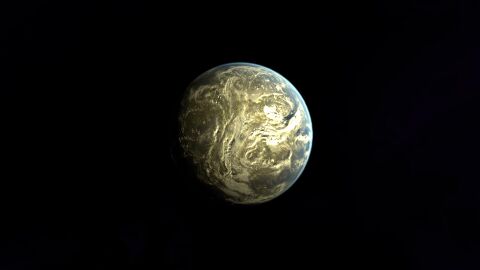
World
Worlds are habitable planets that can be colonized.
Suitability
Each world has a suitability percentage which determines the resource modifier after a world is colonized. Higher suitability yields more resources from colonies. Suitability can be viewed via the system panel, prior to colonizing a world. A species world preference determines the suitability for a planet type. For example, a void world preference would give 100% suitability for void worlds, and 75% for other world types.
World Types
Broken
These once were worlds, but were violently destroyed by some cataclysmic event. These are created during the formation of the galaxy, as star systems cannot have more than one world in New Stars.
